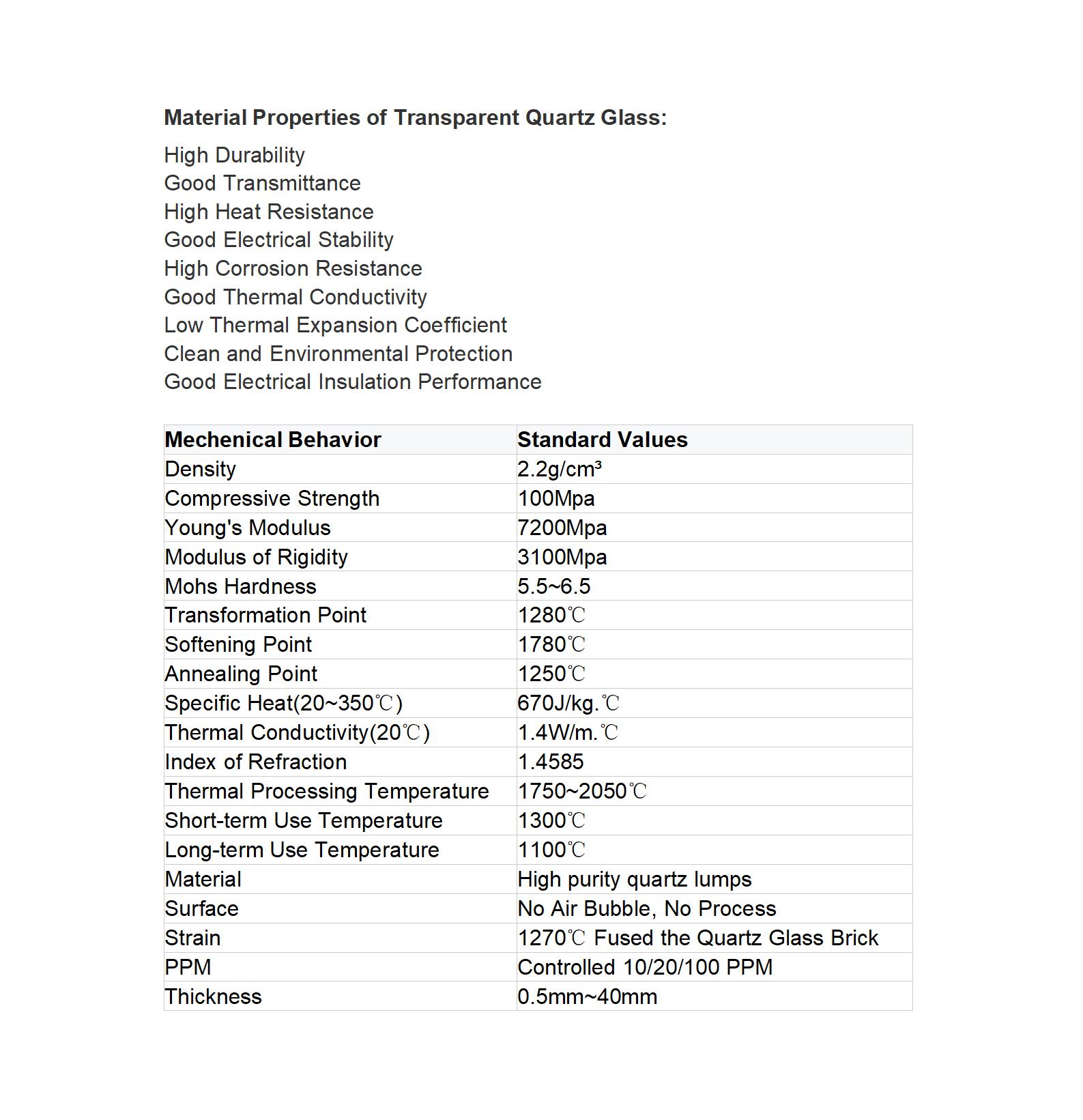T: +86-518-85528012
E: nick@luverrequartz.com
E: nick@luverrequartz.com
1st floor Runlian industrial center No. 116 QuFeng Rd., Haizhou Economic and technological development zone Lianyungang City, Jiangsu Province, China 222062
Various shapes of polished optical quartz glass plates
Polished optical quartz glass plate is a transparent plate made of high-purity silicon dioxide (SiO2).
LUVERRE quartz
99.99%
Inner with Vacuum PVC bag and then wrapped with air bubble film, outer with wooden box.
as per customer's requirement
| Availability: | |
|---|---|
Various shapes of polished optical quartz glass plates
Polished optical quartz glass plate is a transparent plate made of high-purity silicon dioxide (SiO2). It has been precisely processed and polished to meet the strict requirements for surface smoothness, transmittance, and reflectivity in optical applications.
Material properties.
- High purity: It usually contains more than 99.9% silica dioxide, and the impurity content is extremely low, ensuring the purity of the material.
- Excellent optical properties: It has a very high transmittance, especially in the ultraviolet (UV), visible light, and infrared (IR) bands.
- Low thermal expansion coefficient: This makes it have good dimensional stability in temperature changes, which is suitable for applications that require precise size control.
- High temperature resistance: It can withstand higher temperatures and is suitable for use as optical components in high-temperature environments.
- Chemical stability: It has good resistance to most acids, alkalis, and other corrosive substances.

Shape and size.
Polished optical quartz glass plates can be cut into various shapes according to needs, including but not limited to:
- Round plate: Often used in the manufacture of optical components such as lenses and filters.
- Square or rectangular plates: Suitable for applications such as window panes and flat panel displays.
- Polygonal plate: Customized according to specific applications, such as certain typesypes of optical instruments.
- Special-shaped board: Custom-made according to the specific design requirements of customers, to meet the needs of complex structures.
Surface treatment
- Single-sided polishing/Double-sided polishing: Choose single-sided or double-sided polishing according to the use, to ensure the surface is smooth and flawless.
- Coating treatment: In order to improve the reflectivity or transmittance in a specific wavelength range, an anti-reflective coating or other functional coatings can be applied.
- Edge processing: It can be processed such as chamfering and rounding to prevent cracking during use and enhance the aesthetics.

Application field
- Optical instruments: such as microscopes, telescopes, and important components in lasers.
- Semiconductor manufacturing: As a key component of mask templates and testing equipment.
- Scientific research experiments: Widely used in the research of multiple disciplines such as physics, chemistry, and biology.
- Medical equipment: For medical instruments such as endoscopes and surgical lights.
- Aerospace: Due to its lightweight and sturdy characteristics, it is applied in the fields of aerial photography, remote sensing, etc.

Polished optical quartz glass plates, with their excellent optical properties and mechanical strength, play an indispensable role in many fields of modern technology. Whether in scientific research or industrial production, these products provide a solid foundation for achieving more accurate and efficient optical solutions.
Various shapes of polished optical quartz glass plates
Polished optical quartz glass plate is a transparent plate made of high-purity silicon dioxide (SiO2). It has been precisely processed and polished to meet the strict requirements for surface smoothness, transmittance, and reflectivity in optical applications.
Material properties.
- High purity: It usually contains more than 99.9% silica dioxide, and the impurity content is extremely low, ensuring the purity of the material.
- Excellent optical properties: It has a very high transmittance, especially in the ultraviolet (UV), visible light, and infrared (IR) bands.
- Low thermal expansion coefficient: This makes it have good dimensional stability in temperature changes, which is suitable for applications that require precise size control.
- High temperature resistance: It can withstand higher temperatures and is suitable for use as optical components in high-temperature environments.
- Chemical stability: It has good resistance to most acids, alkalis, and other corrosive substances.

Shape and size.
Polished optical quartz glass plates can be cut into various shapes according to needs, including but not limited to:
- Round plate: Often used in the manufacture of optical components such as lenses and filters.
- Square or rectangular plates: Suitable for applications such as window panes and flat panel displays.
- Polygonal plate: Customized according to specific applications, such as certain typesypes of optical instruments.
- Special-shaped board: Custom-made according to the specific design requirements of customers, to meet the needs of complex structures.
Surface treatment
- Single-sided polishing/Double-sided polishing: Choose single-sided or double-sided polishing according to the use, to ensure the surface is smooth and flawless.
- Coating treatment: In order to improve the reflectivity or transmittance in a specific wavelength range, an anti-reflective coating or other functional coatings can be applied.
- Edge processing: It can be processed such as chamfering and rounding to prevent cracking during use and enhance the aesthetics.

Application field
- Optical instruments: such as microscopes, telescopes, and important components in lasers.
- Semiconductor manufacturing: As a key component of mask templates and testing equipment.
- Scientific research experiments: Widely used in the research of multiple disciplines such as physics, chemistry, and biology.
- Medical equipment: For medical instruments such as endoscopes and surgical lights.
- Aerospace: Due to its lightweight and sturdy characteristics, it is applied in the fields of aerial photography, remote sensing, etc.

Polished optical quartz glass plates, with their excellent optical properties and mechanical strength, play an indispensable role in many fields of modern technology. Whether in scientific research or industrial production, these products provide a solid foundation for achieving more accurate and efficient optical solutions.